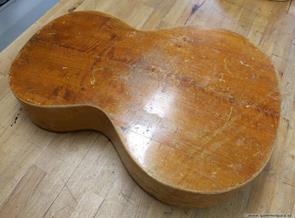An unusual yeast and dry European parlor from about 1910-1920 became a finished Old Gura. The condition was not the best, the throat had a bang and the lid cracked and loosened on either side of the grip board and pushed forward into the sound hole. At the same time, the rest of the lid had burst into wide cracks. With the lid under the grip board forced and glued in the right place, the cracks became tighter and it wasn't as bad as it first seemed. Got to fill in the widest cracks with more wood, the others were fine cracks that could easily be glued together.
Made a new stable with the original as a template. The original was in black painted birch or soft maple and not strong enough for a stable leg.
"Turbo plugs" were fitted. A solid surface for the string ball gives better volume and a clearer sound.
One of the guitars I am working on had wide notches in the head, the string posts on the new tuning screws were a little too short. A trick is to drill the holes a little bigger and require with "grommets" which are used for tuning screws on flat heads. Since it is not wrong to have metal against metal, I did the same thing on all the guitars. Glue with fish glue, it is important to clean them with T-spirit so that the glue sticks to it properly.
The first string with loosely mounted straps, an old upper saddle, drills such as stable legs and plastic sticks in the stable. It sounds promising, the drier and cracked the original is, the better it usually sounds. An unusual detail on this guitar was the steep angle of the head, lying flat against a table resting on the head and not against the whole bottom. It has to be a little careful.
The guitar was strapped to my jig to freeze the neck in the position it gets with taut strings. The fretboard was ground to a minimal relief. Then picked loose from the jig for strapping and then into the jig one last time to crown and polish the straps. Now uses a Z file to crown the ribbons. You get a slightly sharper top on the straps that tunes in better when you play (with a wide round top, the point of contact between the strap and string "wanders" depending on how hard you press). Also moved over the fretboard decorations from the old board while it was stuck in the jig. The old ebony board was too thin and the straps were not quite where they should be.
For the first time I painted the rosewood stable black. Similar to the original, but the porous rosewood wood reveals what it is up close. Also pasted on a transparent plectrum cover. The spirit varnish is soft and you can always count on abrasion if you play with the pick room. It can be removed with a hair dryer and patience if you so wish. Intoned upper saddle and made a composite stable leg and mounted a K&K mic. I now make composite stable legs with two wider pieces of bone at the end. Sounds good I think 🙂























